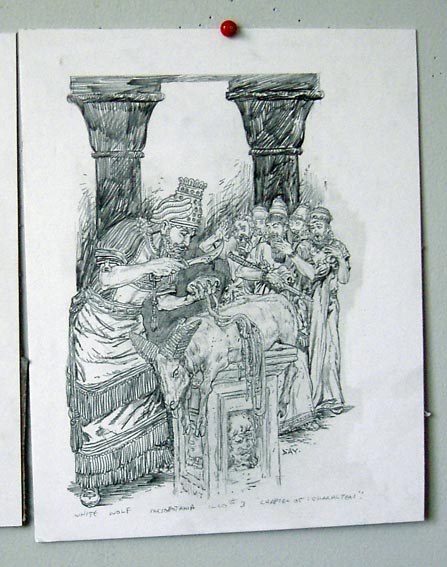Echoes of Ibnath
Just came across a mention and short review of Ancient Kingdoms: Mesopotamia, a book I wrote for Necromancer Games back in 2004, over at the Planet Algol blog.
Bill Webb, co-founder of Necromancer Games, approached me back in 2003, and, based on my work on the Hyborian Age Campaign Website, basically gave me free reins to write whatever I wanted. After digging through my old files, here is the initial outline for a book that I submitted to Bill:
I’d like to present to you an idea I have for a mini-campaign. The main concept is the exploration of two lost cities connected to each other by magical gates (although they can also be reached by overland travel).
“City one” is a dead city of the great desert, buried for centuries beneath the desert sands. At the beginning of the campaign, a great sandstorm uncovers the ruins of the city. It is first discovered by desert nomads, but soon attracts the attention of adventurers, including the player characters. As they explore the ruins, they slowly uncover the history of the city and learn of “something” of great power buried in the tombs beneath the city. The ruins are crawling with undead and other foul monsters, of course.
Possible supporting material for “city one” includes:
- The trek through the great desert, where perils include sudden sandstorms, desert raiders and predatory beasts.
- Defeating monsters and finding treasure in an oasis near the lost city.
- Interacting with the desert tribe that first discovered the city.
- Hearing legends of an immense sand-worm that lives beneath the sand near the city, rumored to cause earth-quakes unless appeased with sacrifice by a worm-cult.
- Exploring outlying towers or other outposts of the city itself.
- Interacting with and/or defeating various kinds of undead and monstrous inhabitants of the city, such as a ghoul-queen, a terrible one-eyed bat, an immortal sphinx guarding secret wisdom, and spectral priests haunting the city’s temples.
- Exploring the cyclopean architecture of the lost city, learning its history. The principal locations of the city include a great temple guarded by undead clerics, an artificial sacred lake, several gargantuan obelisks inscribed with powerful sorcery, and the trap-filled tombs beneath the city.
- Finding the gate that leads to “city two”.
“City two” is a hidden city of the jungle, inhabited by a race of serpent-people and ruled by a powerful sorcerer (the grand villain of the mini-campaign). The city is surrounded by the lands of cannibal tribes worshipping foul, alien gods. The city itself is an immense labyrinth where all chambers are interconnected. During their explorations, the player characters might discover that the key to defeating the sorcerer-king of “city two” is to be found in “city one” (the desert city). The existence of a gate between the two cities allows the player characters to travel back and forth between the two settings, while also allowing the main villain to send his servants to harass intruders anywhere.
Possible supporting material for “city two” includes:
- The lands of the cannibal tribes, with shamans worshipping strange gods.
- A lake inhabited by a monstrous being whose strange dreams draw humans to it.
- Labyrinthine, interconnecting chambers inhabited by serpent-people with strange magics and treasures; shrines dedicated to the ancient serpent-god; and sacrificial pits where huge snakes slither across the yellowed skulls and bones of countless victims.
- An undercity inhabited by slime-covered, tentacled beasts, and albino savages who were once men but are reverting to ape-kind.
- The deadly lair of the city’s sorcerer-king, guarded by his serpent minions.
The two cities of the mini-campaign will be set in a generic sword-and-sorcery location which includes barbarian warrior lands to the north, a great but corrupted city-state on the central plains, a great desert inhabited by nomads to the southwest, and savannah fading into dense jungle to the south.
I’ll be aiming for a feel combining elements of Robert E. Howard’s Conan, H. P. Lovecraft’s Cthulhu Mythos, mixed with the usual elements of fantasy adventures. The world will be dominated by humans (mighty warriors, evil sorcerers and beautiful women) and filled with exotic locales. Standard D&D magic rules apply, but magic items and flashy spells will be uncommon. However, there will be no shortage of tentacled gods, powerful necromancy and strange relics of bygone ages.
As it turned out, “city one” was enough for one book by itself; it became Ibnath, “a city of unspeakable antiquity”, also known as “the City That Worshipped a Thousand Gods”. (Side note: Perhaps if you want to use the original idea of two linked cities, you could use Dwellers of the Forbidden City as that second city, it would fit the bill quite nicely.)
Clark Peterson, the other co-founder of Necromancer Games, listed Ancient Kingdoms: Mesopotamia as one of his all-time Top Five books from Necromancer Games. He also happens to own the original cover painting by Rick Sardinha (hey Clark, if you ever need money, I’ll give you a good price for that painting! :-).
Inspired by a certain big award ceremony, I’d like to take this opportunity to send a big thank you to Bill and Clark for giving me the opportunity to write a “real book” back in the heydays of Third Edition D&D. Who knows when Necromancer Games will be resurrected from the dead? You know, that is not dead which can eternal lie….
